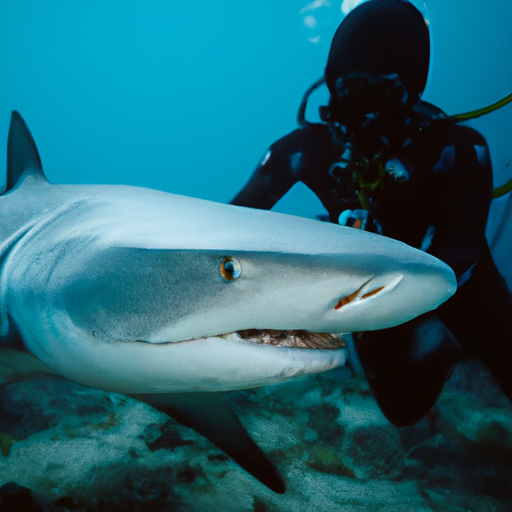So you’ve always dreamed of going shark diving, but you can’t help but wonder, is it safe? The allure of swimming with these majestic creatures is hard to resist, but the potential dangers loom large in your mind. In this article, we will explore the world of shark diving and answer the question on everyone’s mind: is it safe to go shark diving? By examining the risks, safety measures, and expert opinions, we’ll give you a comprehensive overview to help you make an informed decision about pursuing your underwater adventure.
The Importance of Shark Diving Safety
Shark diving is an exhilarating and unforgettable experience that allows you to get up close and personal with these magnificent creatures. However, it is crucial to prioritize safety when engaging in this adventurous activity. Understanding the risks involved, obtaining proper training and certification, and having the right equipment and safety measures in place are essential for a safe and enjoyable shark diving experience.
Understanding the Risks
Shark diving carries inherent risks due to the unpredictable nature of these apex predators. Despite their fascinating behavior and beauty, sharks are still wild animals and should be treated with caution and respect. Understanding the risks involved is crucial in order to make informed decisions and take necessary precautions. While the chances of a shark attack are extremely rare, it is important to be aware of potential dangers and be prepared for any unforeseen circumstances.
The Role of Training and Certification
To ensure your safety and minimize risks while shark diving, it is crucial to undergo proper training and obtain certification. Reputable shark diving operators offer comprehensive training programs that cover important topics such as understanding shark behavior, recognizing signs of aggression, and implementing effective safety measures. These courses equip divers with the knowledge and skills needed to handle various situations and ensure a safe diving experience.
Equipment and Safety Measures
Investing in high-quality equipment and adhering to strict safety measures is imperative when engaging in shark diving. Wearing a well-fitted wetsuit, gloves, and booties can provide protection against scratches and bites in case of any accidental physical contact with a shark. Additionally, using a sturdy and reliable shark cage, if applicable, can provide an extra layer of safety. It is also essential to have emergency equipment such as first aid kits and emergency oxygen readily available in case of any unforeseen incidents. By prioritizing the use of proper equipment and implementing safety measures, you can minimize risks and ensure a safe diving experience.
Examining Common Shark Misconceptions
Misconceptions about sharks often lead to unnecessary fear and misconceived notions about their behavior. By debunking these misconceptions, we can gain a better understanding of these magnificent creatures and approach shark diving with a more informed perspective.
Sharks’ Natural Behavior
Contrary to popular belief, sharks are not mindless killing machines. They play a vital role in maintaining the health of our oceans and ecosystems. Sharks are typically curious creatures that investigate unfamiliar objects and environments by using their natural senses. Understanding their behavior, such as differentiating between investigative behaviors and aggressive behaviors, can help foster a greater appreciation for these incredible animals.
Sharks and Preying on Humans
The portrayal of sharks as bloodthirsty man-eaters in popular culture has created a significant misconception about their behavior towards humans. While it is essential to remember that sharks are apex predators and should be treated with respect, the reality is that they have no inherent desire to target humans as prey. Most incidents involving sharks are cases of mistaken identity or defensive reactions to perceived threats. The chances of being attacked by a shark are extraordinarily low, and proper precautions can further minimize this risk.
Sharks and Blood Attraction
Contrary to popular belief, sharks are not universally attracted to the scent of blood from miles away. While sharks possess an acute sense of smell and can detect blood in the water, they are not automatically drawn to it. Sharks primarily use their sense of smell to locate their natural prey, such as injured or distressed fish. It is essential to dispel this misconception to ensure that divers understand that merely being in the water with sharks does not make them an immediate target.

Choosing a Reputable Shark Diving Operator
Selecting a reputable shark diving operator is crucial to ensure your safety, as well as the ethical treatment of sharks. Thoroughly researching the operator’s track record, evaluating their safety measures and protocols, and reading customer reviews are important steps in making an informed decision.
Researching the Operator’s Track Record
Before committing to a shark diving operator, it is essential to conduct thorough research on their reputation and track record. Look for operators with a proven history of implementing strict safety measures and adhering to ethical guidelines. Check for any past incidents or accidents and assess how the operator handled them. A reliable operator will prioritize the safety and well-being of both divers and the sharks themselves.
Evaluating Safety Measures and Protocols
When considering a shark diving operator, carefully evaluate the safety measures and protocols they have in place. The operator should have a well-maintained and reliable fleet of boats, ensuring that the vessels are equipped with necessary safety equipment, including life jackets, emergency flares, and communication devices. Additionally, operators should have comprehensive emergency response plans and protocols in the event of unforeseen circumstances. It is important to choose an operator that prioritizes safety above all else.
Reading Customer Reviews
One of the most reliable ways to assess the quality and safety standards of a shark diving operator is by reading customer reviews. Look for reviews from recent customers who have had firsthand experiences with the operator. Pay attention to feedback regarding safety protocols, equipment quality, and overall customer satisfaction. Positive reviews from divers who felt safe and had an enjoyable experience can provide valuable insights into the credibility and reliability of the operator.
Preparation for Shark Diving
Preparing adequately for shark diving involves understanding the diving requirements, considering physical fitness and medical considerations, and managing fear through mental preparation.
Understanding the Diving Requirements
Before embarking on a shark diving expedition, it is crucial to understand the diving requirements specific to the chosen method. Different types of shark diving, such as cage diving, open water diving, or feeding and interaction dives, have unique prerequisites. Ensure that you meet the minimum experience and certification level required for the chosen dive and familiarize yourself with any additional training or skills necessary. Being adequately prepared will enhance your safety and enjoyment during the dive.
Physical Fitness and Medical Considerations
Shark diving can be physically demanding, so it is important to assess your physical fitness level and consider any potential medical considerations. Consult with a medical professional to ensure that you are in good health and physically capable of partaking in this thrilling activity. As part of your preparation, it may be beneficial to engage in regular physical exercise to improve your overall fitness and stamina. Being in good physical condition will contribute to a safer and more enjoyable diving experience.
Mental Preparation and Managing Fear
Shark diving can evoke a range of emotions, including excitement and fear. It is normal to experience some level of anxiety or apprehension before diving with sharks, especially if it is your first time. Engaging in mental preparation techniques, such as visualization and controlled breathing exercises, can help manage fear and anxiety. Educating yourself about the behavior and importance of sharks can also help foster a positive mindset and reduce any unnecessary apprehension. By mentally preparing yourself, you can approach shark diving with confidence and enjoy the experience to the fullest.

Understanding the Different Types of Shark Diving
Shark diving offers a variety of experiences, each with its own set of characteristics and requirements. Understanding the different types of shark diving, such as cage diving, open water diving, and feeding and interaction dives, can help you choose the option that best suits your preferences and comfort level.
Cage Diving
Cage diving is one of the most popular forms of shark diving, offering a safe and controlled environment for observing sharks up close. Divers are submerged within a secure metal cage, providing a protective barrier while still allowing an immersive experience. This method is often chosen by individuals who prefer a more controlled interaction with sharks or who may be new to diving. Cage diving provides a thrilling opportunity to see these magnificent creatures in their natural habitat while prioritizing the safety of both divers and sharks.
Open Water Diving
Open water diving involves diving freely in the shark’s natural environment, without the protection of a cage. This method offers a more immersive and intimate experience, allowing divers to observe sharks in their element. Open water diving requires a higher level of experience and certification, as divers must be comfortable and competent in managing themselves in the water. It is essential to have thorough knowledge of shark behavior, safety protocols, and effective communication techniques before embarking on open water shark dives.
Feeding and Interaction Dives
Feeding and interaction dives are a unique opportunity to witness sharks during feeding sessions or engage in interactive experiences, such as hand-feeding or petting. These dives allow divers to get even closer to sharks and observe their behavior during feeding frenzies. Feeding dives typically involve attracting sharks using bait, which may not be suitable for all individuals or locations due to potential ecological impact. It is essential to evaluate the ethics and sustainability of feeding and interaction dives, ensuring that operators prioritize the well-being and conservation of sharks.
Diving with Specific Shark Species
Different shark species exhibit unique behaviors and characteristics, offering divers a diverse range of experiences. Understanding the specifics of diving with great white sharks, tiger sharks, and bull sharks can help prepare divers for interacting safely and responsibly with these particular species.
Great White Sharks
Diving with great white sharks is often considered the pinnacle of shark diving experiences. These majestic creatures command respect and awe, and encountering them in their natural habitat is an unforgettable experience. Great white sharks are known for their curiosity, often approaching divers with precision and grace. However, it is important to approach these interactions with caution and respect, following the instructions of experienced dive masters and prioritizing safety above all else.
Tiger Sharks
Tiger sharks are renowned for their impressive size and distinctive markings. Although they are considered apex predators, tiger sharks generally display a more sedate demeanor compared to other aggressive shark species. Diving with tiger sharks offers the opportunity to observe their unique behavior patterns and appreciate their beauty. As with any shark diving experience, it is important to follow safety protocols, maintain a respectful distance, and avoid any disruptive or intrusive behavior.
Bull Sharks
Bull sharks are known for their robust build and territorial nature, making encounters with these powerful creatures both thrilling and awe-inspiring. Diving with bull sharks requires a higher level of experience and confidence due to their assertive behavior. It is crucial to approach dives with bull sharks cautiously, following the guidance of experienced professionals and ensuring that safety measures are firmly in place. Respecting their space and behavior is essential to minimize risks and foster a harmonious interaction.

Tips for Safe and Enjoyable Shark Diving
To make the most of your shark diving experience, it is important to follow certain guidelines and practices that prioritize safety and respect for these magnificent animals. By following instructions from dive masters, maintaining a respectful distance, and avoiding any disturbances, you can ensure a safe and enjoyable shark diving experience.
Follow Instructions from Dive Masters
Dive masters are experienced professionals who possess extensive knowledge of shark behavior and safety protocols. It is essential to listen carefully to their instructions and follow their guidance throughout the dive. Pay attention to safety briefings, communication signals, and any specific rules regarding interactions with sharks. By trusting and adhering to the expertise of dive masters, you can navigate the dive confidently and safely.
Maintain a Respectful Distance from Sharks
Respecting the personal space and natural behavior of sharks is crucial to ensuring a safe and ethical shark diving experience. Maintain a respectful distance from the sharks, allowing them to approach on their own terms. Avoid any sudden movements or aggressive behavior that may provoke or intimidate the sharks. By observing from a distance and allowing the sharks to exhibit their natural behavior, you can appreciate their beauty and grace while minimizing any potential risks.
Avoid Touching or Disturbing Sharks
It is important to remember that sharks are wild animals and should never be touched or disturbed during a dive. Touching or attempting to interact physically with sharks can not only harm the animals but also pose risks to divers. Maintain a hands-off approach and appreciate these incredible creatures from a safe distance. This approach not only respects the sharks but also ensures the safety and well-being of both divers and the sharks themselves.
Responsible Shark Tourism and Conservation
Shark diving should be practiced in a responsible and sustainable manner, prioritizing the long-term conservation of these incredible creatures. By supporting conservation efforts, promoting responsible shark feedings, and engaging in sustainable tourism practices, we can contribute to the preservation of sharks and their habitats.
The Importance of Conservation Efforts
Sharks play a crucial role in maintaining the balance of marine ecosystems, and their conservation is vital for the health of our oceans. Supporting conservation organizations and initiatives that focus on preserving shark populations, implementing sustainable fishing practices, and raising awareness about their importance is pivotal. By actively participating in conservation efforts, we can contribute to the long-term survival of these magnificent apex predators.
Responsible Shark Feedings
While shark feedings may provide thrilling and unique diving experiences, it is essential to prioritize the well-being of sharks and the ecosystems they inhabit. Responsible shark feedings should adhere to strict guidelines to ensure that the activity does not disrupt natural feeding behavior or endanger the overall health of the shark population. Operators should consider the potential environmental impact of feeding and ensure that the activity is conducted responsibly and sustainably.
Supporting Sustainable Tourism Practices
Engaging in sustainable tourism practices is essential when participating in shark diving activities. Choose operators that prioritize responsible and ethical practices, such as reducing single-use plastics, supporting local conservation initiatives, and minimizing the impact on marine habitats. By supporting sustainable tourism, we can enjoy the thrill of shark diving while promoting the long-term well-being of the sharks and their ecosystems.

Real-Life Experiences of Shark Diving
Real-life experiences of shark diving can provide invaluable insights and perspectives on the thrill, lessons learned, and the importance of responsible shark diving. Personal stories shared by individuals who have encountered sharks in their natural habitat allow us to appreciate the wonders of these creatures and understand the significance of safety and conservation measures.
Stories of Thrilling Encounters
Real-life stories of thrilling shark encounters serve as a testament to the power and majesty of these creatures. Hearing firsthand accounts of divers who have witnessed sharks up close can ignite curiosity and inspire a desire to experience these awe-inspiring moments for oneself. These stories also highlight the importance of following safety protocols and respecting the sharks’ natural behavior to ensure a safe and unforgettable experience.
Lessons Learned and Personal Perspectives
Every shark diving experience teaches valuable lessons and imparts personal perspectives on the beauty and significance of these creatures. Divers often gain a deeper understanding of shark behavior, the importance of conservation, and the fragility of marine ecosystems. Exploring these insights can cultivate a greater respect and appreciation for sharks and motivate individuals to become advocates for their protection.
Promoting Responsible Shark Diving
Real-life experiences of responsible shark diving can inspire others to approach this thrilling activity with safety and conservation in mind. Sharing stories that emphasize the importance of ethical practices, adherence to safety protocols, and conservation efforts can contribute to the responsible development of shark diving as a sustainable tourism activity. By promoting responsible shark diving, we can inspire others to engage in this incredible experience while ensuring the continued well-being of sharks and their habitats.
Conclusion
Shark diving offers an exhilarating adventure for those seeking a unique and unforgettable experience. By prioritizing safety, debunking common misconceptions, choosing reputable operators, adequately preparing for dives, understanding different shark species, and engaging in responsible practices, we can make the most of this thrilling activity while promoting safety and conservation efforts. As you embark on your shark diving journey, remember to approach it with an open mind, respect for these incredible creatures, and a commitment to protecting their future. Through careful preparation and responsible practices, you can embark on an exciting and meaningful shark diving experience while contributing to the preservation of these magnificent apex predators and their habitats.

- Can You Dive With Sharks In California? - August 19, 2024
- What Are The Rules Of Shark Cage Diving? - August 19, 2024
- Where In Florida Can You Dive With Sharks? - August 19, 2024








